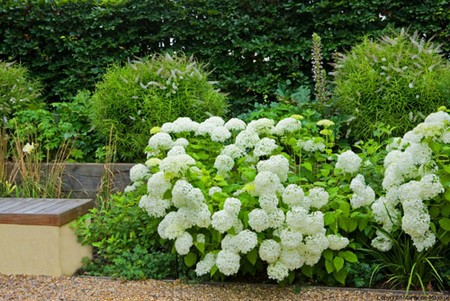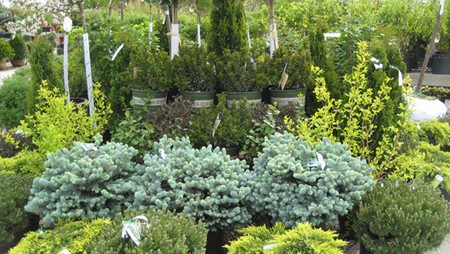Best Way to Save Time and Money on Hedges, Shrubs and Trees
Tidying up hedges
Shaping hedges: In areas where heavy snow falls are an annual occurrence, trim the tops of hedges with a slight slope so that snow has a better chance of falling off. Hedges are severely damaged when a thick covering of snow causes the branches to spread open or the whole hedge to bend over.
Bases of hedges: Always remove hedge clippings and ensure that the base does not become thick with them. If left, they reduce the circulation of air and encourage the presence of pests and diseases; they also make the hedge unsightly.
Shrubs
- New shrubs for old: Shrubs with low-growing branches can be inexpensively increased by layering a few branches. During late summer or early autumn, lower a pliable, healthy shoot to soil-level and peg it into a shallow trench, 7.5-10cm deep and 23-45cm from the shoot’s tip. Either cut a tongue on the shoot’s lower side and about 30cm from its tip, or cut half-way around the stem and remove part of the bark. Use a stout peg to hold the shoot in place. Firm soil around the stem. Rooting takes about a year – sometimes longer.
- New heathers for old: Heathers, ericas and daboecias which are old and have become bare at their centres can be encouraged to produce new plants by forming a mound of friable soil in their centres. This is best performed in autumn or spring. Work the soil between the stems and then thoroughly water the entire plant. Later, when the stems have developed roots, dig up the complete plant and cut off the rooted parts. If small, plant them into a nursery bed until they are established.
- Tender shrubs in tubs: Tender shrubs in tubs on patios may require protection from cold winter winds. In early winter, insert three canes into compost at the edge of the tub and form them into a wigwam. Tie their tops together. Then, spread a thin layer of straw around them, so that the shrub is cocooned. Tie a piece of string to the base of a cane and wind it upwards in a spiral, so that it holds the straw in place. Remove the canes and straw in late winter.
- Shrubs in tubs: The compost in tubs often becomes too wet in winter. To prevent this happening and damaging a shrub’s roots, cover the compost with polythene held in place by encircling the tub with string. Check that water runs towards the rim of tub, and not to the centre.
Trees
- Wind damage: Fierce winds sometimes loosen ‘ties’ securing a trunk to a supporting stake. If the stake is undamaged, an improvised ‘tie’ can be made with a couple of old stockings or a pair of tights; make sure that the trunk does not rub against the stake. Broken stakes: Where a vertical stake is broken, remove it and replace it with an H-shaped or an obliquely-angled stake. An H-shaped support is formed by two vertical stakes being knocked into the ground, 23-30cm either side of the trunk, and a stake then being tied between them and to the trunk. Another way to proceed is to knock an oblique stake into the ground, about 38cm (15m) from the trunk, at an angle of 45 degrees and with its top pointing towards the prevailing wind. Tie the top part of the stake to the trunk.
- Heavy fruit crops: These often weigh down branches and, occasionally, break them. Lift up the branch and use a Y-shaped prop to hold it in place.
- Removing a large branch: Always cut off a large branch a few feet at a time; never immediately cut it close to the trunk.
- Heavy snow falls: These soon damage branches, bending them down and causing the tree or shrub to become deformed. Consequently, always carefully remove snow either by gently tapping the branches or by using a soft brush.
Categories
Advertisements
Recent Articles
 How to Understand Bed Sizes – A Small Guide
How to Understand Bed Sizes – A Small Guide How to Select Some Must Have Kitchen Accessories
How to Select Some Must Have Kitchen Accessories Best Way to Change a Car Tire
Best Way to Change a Car Tire Best Way to Write an Affirmation
Best Way to Write an Affirmation Best Way to Take Charge of Your Financial Life
Best Way to Take Charge of Your Financial Life Best Way to Survive a Party When You Don’t Know Anyone
Best Way to Survive a Party When You Don’t Know Anyone Best Way to Stop Self Sabotaging Yourself
Best Way to Stop Self Sabotaging Yourself Best Way to Start Journal Writing
Best Way to Start Journal Writing Best Way to Speak with a Powerful Voice
Best Way to Speak with a Powerful Voice Best Way to Simplify Your Life
Best Way to Simplify Your Life Best Way to Respond to a Put-Down
Best Way to Respond to a Put-Down Best Way to Reduce Acne Breakouts
Best Way to Reduce Acne Breakouts Best Way to Recover from Dining Disasters
Best Way to Recover from Dining Disasters Best Way to Quit Your Job Gracefully
Best Way to Quit Your Job Gracefully Best Way to Make Your Own Website
Best Way to Make Your Own Website
Tags
Acid Reflux
Allergy
Aromatherapy
Baby
Baby Learn
Beauty
Bed Rest
Child
Decorate Garden
Depression
Develop Baby Skills
Exercise
Feng Shui
Garden
Golf
Golf Swing
Growing Herbs
Hair
Herbs
Improve Garden
Interview
Interviews
Kitchen
Life
Makeup
Massage
Meditation
Newborn Baby
Plant
plants
Pregnancy
Reduce Stress
Relax
Sales Team
School
Skin
Skin Care
Stress
Stress Reducing
Teach Child
Teacher
Teaching
Train Dog
Understand Baby
Vegetable Garden



Leave a Reply